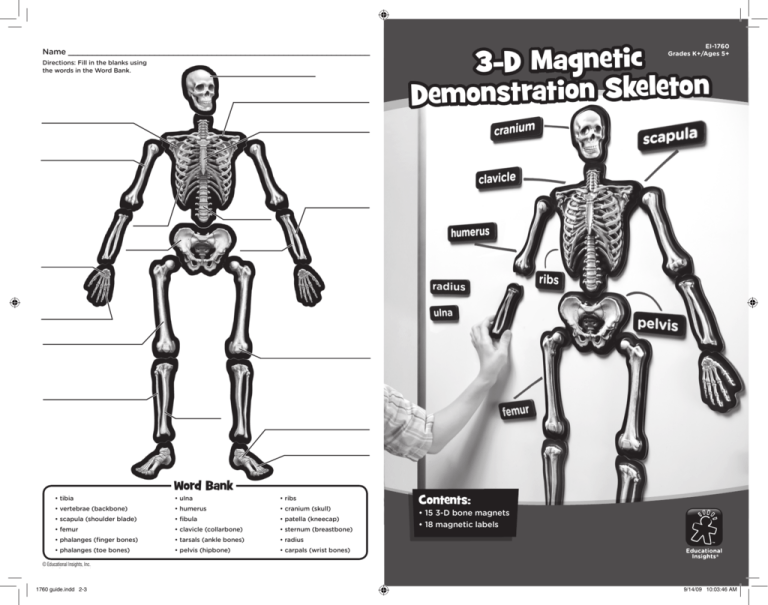
Name _______________________________________________________________
Directions: Fill in the blanks using
the words in the Word Bank.
Word Bank
• ulna
• ribs
• vertebrae (backbone)
• humerus
• cranium (skull)
• scapula (shoulder blade)
• fibula
• patella (kneecap)
• femur
• clavicle (collarbone)
• sternum (breastbone)
• phalanges (finger bones)
• tarsals (ankle bones)
• radius
• phalanges (toe bones)
• pelvis (hipbone)
• carpals (wrist bones)
• tibia
© Educational Insights, Inc., Gardena, CA (U.S.A.). All rights reserved.
Learning Resources Ltd., King’s Lynn, Norfolk (U.K.).
Please retain this information. Made in China.
www.EducationalInsights.com
1760 guide.indd 2-3
Fabriqué en Chine.
Made in China.
Hecho en China.
3-D Magnetic
Demonstration Skeleton
EI-1760
Grades K+/Ages 5+
Contents:
• 15 3-D bone magnets
• 18 magnetic labels
TM
Informations à conserver.
Bitte bewahren Sie unsere
Adresse für spätere Nachfragen auf.
Conservar estos datos.
9/14/09 10:03:46 AM
Demonstration Skeleton
Introduce the Skeleton
Put the skeleton together on the board. Discuss the purpose of a skeleton
(a structure that supports the body and protects the heart, lungs, and brain).
Ask students to tell which, if any, bones they have broken. Discuss x-rays and
what they allow doctors to see. Call on students to tell you names of bones
they know. As they do so, put the magnetic label next to the correlating
bone. Say each name aloud. Afterward, label any remaining bones. Ask
students to repeat each bone name while pointing to where that bone is on
their own bodies.
Where Does This Bone Belong? What Bone is This?
Set Up
Draw a circle on the board and label it Bone Bank. Mix up all the bones and
place them in the circle. Draw another circle on the board and label it
Bone Bank. Place the bone names in the circle. Place the rib cage magnet in
the center of the board.
Demonstration Skeleton
5.Continue calling on students to place bones and labels until the skeleton
is complete and all the labels are placed. If students know names of
additional bones, use a whiteboard marker to write those bone names
next to the appropriate bones.
Guess-the-Bone Riddles
Challenge students to guess which bone you’re describing. Here are four
examples:
1. This set of bones protects the heart and lungs. (answer: ribs)
2. This bone protects the brain. (answer: cranium)
3. This is your hipbone. (answer: pelvis)
4.This bone stretches from the elbow to the thumb side of the wrist.
(answer: radius)
Find the Bone
Pass out the bones to students. Ask the students who are holding a bone/
bone set that comes in an identical pair to find the other student with that
same bone/bone set and sit together. For example, the students who are
each holding a humerus should sit next to each other.
Next, pass out the labels to the remaining students. Ask all the students
who are holding bones to raise them up in the air. The students holding the
labels should find the matching bone and sit down next to that (or those)
student(s). Some ‘bone students’ will have more than one ‘label student’
sitting next to them. For example, the students holding the lower leg bones
should have both a student with a tibia label and a student with a fibula label
sitting next to them.
Activity
1.Call on one student at a time to take a bone magnet from the Bone Bank
and properly connect it to a bone on the rib cage magnet.
2.Poll the class to make sure everyone agrees that the bone/bone set is
properly placed.
3.Next, call on a student to come to the board, select a label, and place it
next to the appropriate bone. The student can use a whiteboard marker to
draw a line between the bone and the label. (Draw an arrow to the sternum.)
4.Poll the class to make sure everyone agrees that the label is properly placed.
1760 guide.indd 2-3
Finally, go around the room and ask students to stand up, name the bones/
labels they are holding, and point to where each of those bones is located on
their own bodies.
Using the Reproducible
Copy the reproducible on the next page. (To save paper, copy two on a sheet
and then cut them apart.) Students should fill in the answers using the Word
Bank at the bottom.
© Educational Insights, Inc., Gardena, CA (U.S.A.). All rights reserved.
Learning Resources Ltd., King’s Lynn, Norfolk (U.K.).
Please retain this information. Made in China.
www.EducationalInsights.com
Fabriqué en Chine.
Made in China.
Hecho en China.
Informations à conserver.
Bitte bewahren Sie unsere
Adresse für spätere Nachfragen auf.
Conservar estos datos.
9/14/09 10:03:46 AM









